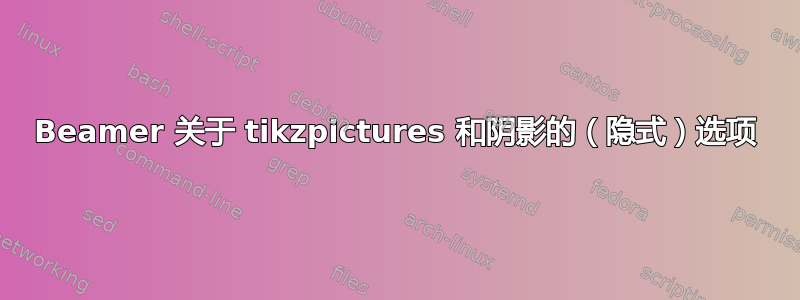
答案1
这个问题得到了一些投票,但答案却隐藏在评论中。总结:这种差异是由于 pdf 查看器造成的。
一切都与 Adobe Reader 配合良好,它应该始终作为参考。
为什么大多数观看者在article使用该职业时能发挥效果,而在beamer使用该职业时却不能,这仍然是一个谜。
根据记录,测试的代码是
\documentclass[a5paper]{beamer}
\usepackage{lipsum} % To generate test text
\usepackage{framed}
\usepackage{tikz}
\usetikzlibrary{decorations.pathmorphing,calc,shadows.blur,shadings}
\pgfmathsetseed{1} % To have predictable results
% Define a background layer, in which the parchment shape is drawn
\pgfdeclarelayer{background}
\pgfsetlayers{background,main}
% This is the base for the fractal decoration. It takes a random point between the start and end, and
% raises it a random amount, thus transforming a segment into two, connected at that raised point
% This decoration can be applied again to each one of the resulting segments and so on, in a similar
% way of a Koch snowflake.
\pgfdeclaredecoration{irregular fractal line}{init}
{
\state{init}[width=\pgfdecoratedinputsegmentremainingdistance]
{
\pgfpathlineto{\pgfpoint{random*\pgfdecoratedinputsegmentremainingdistance}{(random*\pgfdecorationsegmentamplitude-0.02)*\pgfdecoratedinputsegmentremainingdistance}}
\pgfpathlineto{\pgfpoint{\pgfdecoratedinputsegmentremainingdistance}{0pt}}
}
}
% define some styles
\tikzset{
paper/.style={draw=black!10, blur shadow, shading=bilinear interpolation,
lower left=black!20, upper left=black!15, upper right=white, lower right=black!10},
irregular border/.style={decoration={irregular fractal line, amplitude=0.2},
decorate,
},
ragged border/.style={ decoration={random steps, segment length=7mm, amplitude=2mm},
decorate,
}
}
% Macro to draw the shape behind the text, when it fits completly in the
% page
\def\tornpaper#1{
\tikz{
\node[inner sep=1em] (A) {#1}; % Draw the text of the node
\begin{pgfonlayer}{background} % Draw the shape behind
\fill[paper] % recursively decorate the bottom border
decorate[irregular border]{decorate{decorate{decorate{decorate[ragged border]{
($(A.south east) - (0, random*5mm)$) -- ($(A.south west) - (0, random*5mm)$)
}}}}}
-- (A.north west) -- (A.north east) -- cycle;
\end{pgfonlayer}}
}
\begin{document}
\noindent
\tornpaper{
\parbox{.9\textwidth}{\lipsum[11]}
}
\bigskip
\noindent
\tornpaper{
\parbox{.9\textwidth}{\lipsum[15]}
}
\end{document}




